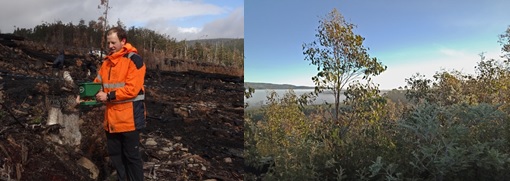Australian Journal of Botany
Volume 68
Number 4 2020
The analysis of spatially localised X-ray diffraction measurements from the stems of woody plants are described in terms of the organisation of cellulose microfibrils in the secondary wall. Simple conclusions may be drawn as to how woody tissue is able to modulate its mechanical properties by controlling the arrangement of cellulose molecules.
Dioecious plants, which have distinct male and female individuals are proportionally rare among Angiosperms, and are at conservation risk because reproduction requires male and female plants in proximity and effective transport of pollen to females. Mechanisms facilitating reproduction were studied in coastal Lomandra leucocephala ssp. robusta, revealing that generalist pollination is utilised and greater male attractiveness may ensure pollen receipt. Through generalist pollination, this species supports diverse insect populations.
Budding and leaf fall of four populations of the arboreal species Maprounea guianensis were evaluated in humid and dry forests to determine the foliar longevity and the intrapopulation phenological diversity. We found low phenological diversity and differences in the habit and leaf longevity of M. guianensis in response to water availability variations. Our results indicate that the phenological behaviour and leaf longevity of M. guianensis favours its occupation of wide varieties of environments due to its high adaptability.
The native hemiparasite plant, Cassytha pubescens, growths on native and invasive species but it has more detrimental effects on invasive plants. The parasite always formed functional connections with invasive hosts. However, one native host blocked parasite penetration, preventing complete development of connections. Variation in host defence responses may lead to reduction in the performance of invasive hosts. This provides a basis for using the parasite for the control of introduced species. Photo: David Hollingworth.
The rationale, design and methods behind a manipulative experiment in which four cool temperate forest tree species were sown in differing combinations is described. An assessment of the success of creating a range of community compositions is also presented. The experiment provides a unique opportunity to test the impacts of the immediate neighbourhood on a range of ecological processes in a cool temperate forest and collaborations are invited.
The historic influence of human fire on ecosystems globally is highly contested, and our knowledge of regime diversity is poor. This paper uses an early European account as a case study to describe Aboriginal fire history in south-eastern Australia based on links between fire and: grasslands, native foods and culture. Establishing such a fire regime ‘benchmark’ has the potential to stimulate new interdisciplinary research around the complex processes controlling grass-tree patterns, and build confidence that fire-stick farming was potentially instrumental in grassland formation, and integral to grassland maintenance throughout this region.











